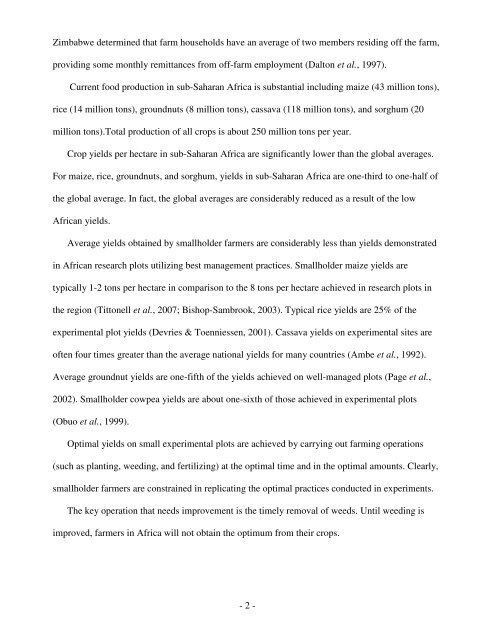solving-africas-weed-problem-report1
solving-africas-weed-problem-report1
solving-africas-weed-problem-report1
Create successful ePaper yourself
Turn your PDF publications into a flip-book with our unique Google optimized e-Paper software.
Zimbabwe determined that farm households have an average of two members residing off the farm,<br />
providing some monthly remittances from off-farm employment (Dalton et al., 1997).<br />
Current food production in sub-Saharan Africa is substantial including maize (43 million tons),<br />
rice (14 million tons), groundnuts (8 million tons), cassava (118 million tons), and sorghum (20<br />
million tons).Total production of all crops is about 250 million tons per year.<br />
Crop yields per hectare in sub-Saharan Africa are significantly lower than the global averages.<br />
For maize, rice, groundnuts, and sorghum, yields in sub-Saharan Africa are one-third to one-half of<br />
the global average. In fact, the global averages are considerably reduced as a result of the low<br />
African yields.<br />
Average yields obtained by smallholder farmers are considerably less than yields demonstrated<br />
in African research plots utilizing best management practices. Smallholder maize yields are<br />
typically 1-2 tons per hectare in comparison to the 8 tons per hectare achieved in research plots in<br />
the region (Tittonell et al., 2007; Bishop-Sambrook, 2003). Typical rice yields are 25% of the<br />
experimental plot yields (Devries & Toenniessen, 2001). Cassava yields on experimental sites are<br />
often four times greater than the average national yields for many countries (Ambe et al., 1992).<br />
Average groundnut yields are one-fifth of the yields achieved on well-managed plots (Page et al.,<br />
2002). Smallholder cowpea yields are about one-sixth of those achieved in experimental plots<br />
(Obuo et al., 1999).<br />
Optimal yields on small experimental plots are achieved by carrying out farming operations<br />
(such as planting, <strong>weed</strong>ing, and fertilizing) at the optimal time and in the optimal amounts. Clearly,<br />
smallholder farmers are constrained in replicating the optimal practices conducted in experiments.<br />
The key operation that needs improvement is the timely removal of <strong>weed</strong>s. Until <strong>weed</strong>ing is<br />
improved, farmers in Africa will not obtain the optimum from their crops.<br />
- 2 -


